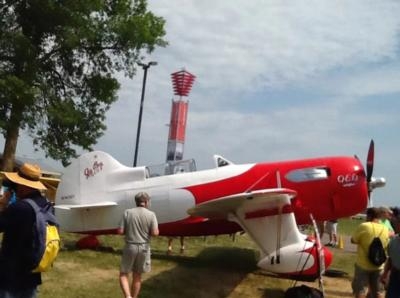Built From Scratch By Various People With Unique Talents
By Maria Morrison
While every aircraft at Oshkosh is something to look at, the GeeBee super QED II is one of the stars of the show this year. Built from scratch under the supervision of late project leader Jim Moss, who passed away September 1, 2013, the QED directly resembles the "standard" racing GeeBee, with a few modifications. There is a different engine, seating for two, and it is twice as large.

Yes, an average adult can stand comfortably underneath the wing of this low-winged airplane, making it twice the size of a R1 or R2 (racer one or racer two) GeeBee. Although the QED was created by the Grandville Brothers, the creators of the GeeBee, it never saw production. The Grandville brothers were struck by the depression in 1934 and went onto separate careers. The single QED that they did create was flown until it crashed into the Potomac river in 1939, then went to a museum in Mexico, where it still sits on display.
The QED, having never become a great racer, was all but forgotten until Jim Moss began researching it in 2002. In 2004, he employed the help of Kenny Brynestad to begin building the tail. Once the tail was done, Brynestad moved onto the wings, using wood supplied by Lyle Sindlinger. He worked from plans that were photographed in a university in Texas, and given to Moss and his crew. Next on the project came Frank Hoogkamer, who welded and fabricated the fuselage. As Jim put it: "Everything on this airplane is attached to what I've (Hoogkamer) done."
Says Hoogkamer of his contributions to the the construction of the R6H. The QED is referred to as the R6H because it is GeeBee Racer number six and has a Hornet engine. However, building this airplane from scratch caused it to have landing gear from a Beech 18 and being powered by a Wright 1820 Cyclone, gaining the nickname R6"C".
Although Cawley's South Prarie Airport in Buckley, Washington is certainly not the most populated airport in the Pacific Northwest, Moss quickly acquired more help for his project. Without going to Mexico to see the original, they began building this one-of-a-kind airplane from the ground up. Tom Fraiser constructed the landing gear and controls. Tom Jenson made the fuel tanks, modifying them several times for CG reasons. Ron Robinson was in charge of all the painting of the aircraft as well as keeping the project alive after Jim Moss' death. Rich Alldredge, along with doing the electrical work, was the test pilot.
The QED first flew on September 26, 2013 at Olympia Regional Airport in Washington. The flight was trouble-free, albeit there were some known CG problems. Although project leader Jim Moss was not there to see the flight, his legacy lives on the both the aircraft he created and the people he brought together. Says team member Hoogkamer, "Jim had a unique way of taking people with unique talents and making them work together."
Prior to taking on the QED project, Jim constructed a wide array of interesting aircraft, including a Laired Super Solution, an aircraft that Jimmy Doolittle flew before moving on to a GeeBee R1. Moss was known for "making things happen," and helping anyone who wanted to learn. "He would stop by every once in a while to check on the progress of our project. Not his project, our project... I am proud have been a part of Jim's life."
The QED will return to its home in Berkley at the end of the week, stopping in Spokane, Washington for a while on the way. It will continue to visit air shows and other aviation events, showing off this one-of-a-kind aircraft.
 ANN's Daily Aero-Term (04.24.24): Runway Lead-in Light System
ANN's Daily Aero-Term (04.24.24): Runway Lead-in Light System ANN's Daily Aero-Linx (04.24.24)
ANN's Daily Aero-Linx (04.24.24) Aero-FAQ: Dave Juwel's Aviation Marketing Stories -- ITBOA BNITBOB
Aero-FAQ: Dave Juwel's Aviation Marketing Stories -- ITBOA BNITBOB Classic Aero-TV: Best Seat in The House -- 'Inside' The AeroShell Aerobatic Team
Classic Aero-TV: Best Seat in The House -- 'Inside' The AeroShell Aerobatic Team Airborne Affordable Flyers 04.18.24: CarbonCub UL, Fisher, Affordable Flyer Expo
Airborne Affordable Flyers 04.18.24: CarbonCub UL, Fisher, Affordable Flyer Expo



